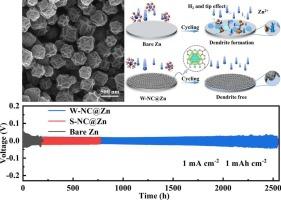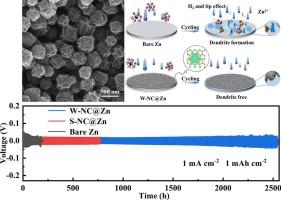表面皱折调制吡啶富氮亲锌位点,实现稳定、快速、均匀的锌沉积
IF 13.2
1区 工程技术
Q1 ENGINEERING, CHEMICAL
引用次数: 0
摘要
锌离子水电池以其成本低、本质安全等优点而备受关注。然而,不受控制的枝晶生长和锌阳极上复杂的副反应大大降低了电池的循环寿命,阻碍了它们的实际应用。在这里,我们设计了一种具有独特褶皱结构(W-NC)的吡啶富氮碳层作为锌阳极的保护层。有限元模拟、理论计算和微观结构表征表明,褶皱结构调节了锌表面的电场强度,引导了锌的均匀沉积。此外,褶皱结构导致更多的吡啶- n亲锌位点暴露,从而进一步抑制枝晶和其他副反应。因此,W-NC@Zn电极具有低的Zn成核过电位,有利于高可逆且无枝晶的Zn沉积。从而实现了优异的电化学性能。当电流密度为1 mA cm−2时,W-NC@Zn||W-NC@Zn对称电池的循环寿命达到2542 h。经过1020次 循环运行后,W-NC@Zn||Cu不对称电池的平均库仑效率为99.51% %。通过对充满VO 2的W-NC@Zn||电池的评价,验证了W-NC@Zn电极的实际应用。通过整合活性位点调制和表面粗糙度工程,我们的研究为广泛的应用提供了优化电极性能的替代方法。本文章由计算机程序翻译,如有差异,请以英文原文为准。


Surface wrinkle modulated pyridinic nitrogen-rich zincophilic sites for stable, fast and uniform zinc deposition
Aqueous zinc ion batteries attract much attention due to the advantages including low cost and intrinsic safety. However, uncontrolled dendrite growth and complex side reactions on Zn anodes significantly reduce the battery cycle life and hinder their practical application. Here, we designed a pyridinic nitrogen-rich carbon layer with a unique wrinkled structure (W-NC) as a protective layer for Zn anodes. Finite element simulations, theoretical calculations, and microstructure characterizations show that the wrinkled structure modulates the electric field strength on the Zn surface and guides the uniform Zn deposition. Moreover, the wrinkled structure leads to the exposure of more pyridinic-N zincophilic sites, which further suppress dendrites and other side reactions. Therefore, the W-NC@Zn electrode exhibits a low Zn nucleation overpotential, facilitates high reversible and dendrite-free Zn deposition. Consequently, excellent electrochemical performance is realized. The cycle life of the W-NC@Zn||W-NC@Zn symmetric cell reaches 2542 h at a current density of 1 mA cm−2. After 1020 cycles operation, the average Coulombic efficiency of the W-NC@Zn||Cu asymmetric cell is 99.51 %. The practical applications of the W-NC@Zn electrodes are also demonstrated by evaluating the W-NC@Zn||VO₂ full cells. By integrating active sites modulation and surface roughness engineering, our studies provide an alternative way to optimize electrode performance for a wide range of applications.
求助全文
通过发布文献求助,成功后即可免费获取论文全文。
去求助
来源期刊

Chemical Engineering Journal
工程技术-工程:化工
CiteScore
21.70
自引率
9.30%
发文量
6781
审稿时长
2.4 months
期刊介绍:
The Chemical Engineering Journal is an international research journal that invites contributions of original and novel fundamental research. It aims to provide an international platform for presenting original fundamental research, interpretative reviews, and discussions on new developments in chemical engineering. The journal welcomes papers that describe novel theory and its practical application, as well as those that demonstrate the transfer of techniques from other disciplines. It also welcomes reports on carefully conducted experimental work that is soundly interpreted. The main focus of the journal is on original and rigorous research results that have broad significance. The Catalysis section within the Chemical Engineering Journal focuses specifically on Experimental and Theoretical studies in the fields of heterogeneous catalysis, molecular catalysis, and biocatalysis. These studies have industrial impact on various sectors such as chemicals, energy, materials, foods, healthcare, and environmental protection.
 求助内容:
求助内容: 应助结果提醒方式:
应助结果提醒方式:


